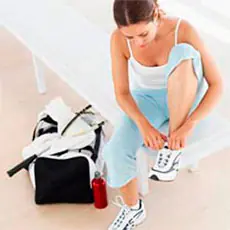Main means of therapeutic physical culture It is generally accepted to consider strength and physical exercises and natural, natural natural factors, additional - mechanotherapy, massage and occupational therapy. Exercise therapy physical therapy includes physical exercises conditionally divided into 3 main components: 1) gymnastics, 2) applied sports and 3) games. The classification of physical exercises was developed by V.N. Moshkov (1954).
Gymnastic exercises are special, artificially combined movements, with the help of which a selective effect is achieved on certain organs and on the entire body in general. As a result, they are divided into: restorative (general developmental), used to improve the health of the whole body, and special, restoring the function of the affected organ or system. In addition, gymnastic exercises are classified according to four signs:
- anatomical,
- execution activity,
- type or nature of exercises,
- use of instruments (gymnastic apparatus) and apparatus.
Based on anatomical characteristics, exercises are distinguished for the muscles of the head, neck, torso, abdominals and pelvic floor, as well as the upper and lower extremities. This division is due to the fact that the level of physical activity directly depends on the volume of muscle mass.
Physiotherapy exercises and sports medicine also share a complex of physical therapy exercises and based on activity. Thus, the exercises are also divided into:
- active, performed by the patient himself,
- passive, which are performed with the help of another person in the absence or severe limitation of the patient’s movements.
Active exercises in order to consistently increase the load are divided in turn into:
- lightweight (in an aquatic environment, on a special sliding surface, etc.),
- free (excluding the power component),
- with effort (volitional, burden, resistance),
- to warm up, stretch and relax muscles.
By nature of muscle contraction highlight:
- dynamic (isotonic) exercises, during which movement is performed, while the length of the muscle changes, but its tension remains unchanged;
- static (isometric) exercises, during which the tension increases, but the length of the muscle does not change and the exercised part of the body does not move;
- idiomotor exercises (performed mentally). They try to carry them out in combination - simultaneously with passive performance of the same exercises.
- respiratory,
- serial and preparatory,
- corrective,
- on coordination of movements and balance,
- throwing movements and catching,
- with resistance,
- all kinds of hangs and stops,
- jumps jumps and hops,
- rhythmoplastic exercises.
Respiratory exercises can be divided into staticperformed without movement of the arms and body, dynamic, combined with various movements, and special, promoting, for example, improving the outflow of sputum, stretching pleural adhesions, etc.
Depending on the use of gymnastic instruments (objects and apparatus), exercises are divided:
- excluding objects and projectiles (without them),
- using objects and projectiles,
- exercises on apparatus.
As gymnastic apparatus in medicine and exercise therapy they use gymnastic sticks, poles, dumbbells, clubs, inflatable or medicine balls, jump ropes, expanders, etc. Among exercise therapy equipment, physical therapy practices the use of gymnastic walls and benches, ropes, an inclined plane, a beam, and others. Exercises on apparatus also include exercises on specialized mechanotherapeutic devices and training complexes.
Sports and applied training is used by physical therapy and sports medicine in order to restore complete movements or their elements. These exercises include grasping and moving objects, alternately throwing and catching balls, all kinds of crawling and climbing, walking and sports walking, light running, various jumps, water gymnastics and swimming, rowing, throwing, skiing, skating, cycling and others...
Games in exercise therapy and sports medicine are conventionally divided in order of increasing load into 4 groups:
- in place (static),
- sedentary (passive),
- mobile (active),
- sports (dynamic).
The most commonly used sports games are table tennis, volleyball, badminton, as well as elements of other games played according to general (classical) or lightweight (simplified) rules.
The best option is when volleyball courts and badminton courts are located outside stuffy walls in clean, oxygen-rich air, and table tennis tables are in well-ventilated and condensable rooms. In general, all of these are so-called natural factors, which we will talk about in more detail in the final part of our article...
- a) solar irradiation during therapeutic physical education classes, as well as sunbathing considered as a hardening technique;
- b) aeration during therapeutic physical training, as well as - similarly, air baths as a hardening technique;
- c) rubdowns (partial or general), douches, showers, bathing and water procedures in fresh water and salt water.



